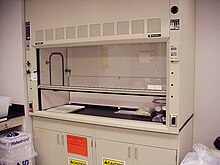Deduction (laboratory)
A fume cupboard or hood (also digester or digestorium , especially in Switzerland also a chapel ) is an important part of scientific laboratories , especially in chemistry , and is used to work safely and to protect the experimenter.
The construction and testing of fume cupboards are regulated in the European standard EN 14175.
Such a fume cupboard consists of a fire- and chemical-resistant work surface enclosed by solid walls, a movable front window (depending on the design also with movable side windows) and a suitable ventilation system that serves to immediately remove gases , dusts and aerosols that arise during experiments suction from the air. Most fume cupboards are equipped with connections for electricity , natural gas , nitrogen and cooling water as well as drains.
The movable panes provide access to the work area and, when closed, protect the laboratory and workers in the event of an accident ( delayed boiling , uncontrolled reactions , fires and smaller explosions ) from splinters, splashing liquids or the spread of a fire.
In order to constantly check the functionality of the extraction system, flags or plastic wind turbines are installed in front of the air shafts in older fume cupboards to make the air flow visible; In newer devices, a control device is integrated in the trigger unit, which sends out warning signals if the suction power is too low. The optimum suction power is only guaranteed when the windows are closed, whereby there must always be a narrow opening between the front window and the work surface.
Whether the use of a fume cupboard is necessary can usually be found in the relevant safety data sheet for the hazardous substances used . If a risk of fire, dust or gas development cannot be ruled out, a fume cupboard must be used in any case.
Other systems
- Deductions are sometimes confused with safety cabinets. In contrast to fume cupboards, however, safety workbenches only provide protection against particles and aerosols with the help of filters. However, the filtered air is returned directly to the laboratory room, gases and vapors are not retained in their filters.
- Glove boxes , also called glove boxes , are not fume cupboards, but closed work spaces that are hermetically separated from the environment. Defined environments can be created in them, for example extremely dry and / or low in oxygen, in order to be able to work with correspondingly sensitive substances or objects such as many organometallic compounds . The name glove box arises from the fact that there are permanently installed gloves in the box for handling, into which the hands of the experimenting person can be inserted from the outside. Substances and objects have to be brought into the boxes via a lock system, which can be quite time-consuming depending on the requirements.
- So-called scrubber fume cupboards clean the exhaust air, which is mostly contaminated by acid, by washing it out and then neutralizing it
- Workplaces for hazardous materials are very similar to fume cupboards, but in contrast to these do not have a front lock.
Individual evidence
- ↑ Brockhaus ABC Chemie , VEB FA Brockhaus Verlag Leipzig 1965, p. 16
- ↑ A washer's deduction? How does it actually work? Retrieved on March 19, 2020 (German).
- ↑ asecos (manufacturer): GAP (Hazardous Substance Workplace ). Retrieved April 21, 2020 .

